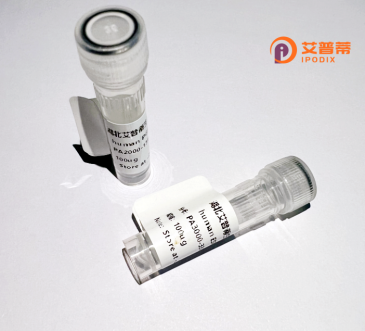
| 纯度 | >90%SDS-PAGE. |
| 种属 | Human |
| 靶点 | ZNF446 |
| Uniprot No | Q9NWS9 |
| 内毒素 | < 0.01EU/μg |
| 表达宿主 | E.coli |
| 表达区间 | 1-450 aa |
| 活性数据 | MPSPLGPPCLPVMDPETTLEEPETARLRFRGFCYQEVAGPREALARLRELCCQWLQPEAHSKEQMLEMLVLEQFLGTLPPEIQAWVRGQRPGSPEEAAALVEGLQHDPGQLLGWITAHVLKQEVLPAAQKTEEPLGSPHPSGTVESPGEGPQDTRIEGSVQLSCSVKEEPNVDGQEVAPSSPPLAAQSPEGNHGHQEPASTSFHPPRIQEEWGLLDRSQKELYWDAMLEKYGTVVSLGLPPHQPEAQAQSELGMLLTGTGVCRSLRSGNESEGPPGCPEAQPPQGPGPAAWEGLSGAATPAPTVRPGTPPVPTQPTPAETRLEPAATPRKPYTCEQCGRGFDWKSVFVIHHRTHTSGPGVQSPGLATGESTEKPPQGEVAFPHHPRRSLTGPRSYPCEECGCSFSWKSQLVIHRKSHTGQRRHFCSDCGRAFDWKSQLVIHRKGHRPEVP |
| 分子量 | 75.4 kDa |
| 蛋白标签 | GST-tag at N-terminal |
| 缓冲液 | PBS, pH7.4, containing 0.01% SKL, 1mM DTT, 5% Trehalose and Proclin300. |
| 稳定性 & 储存条件 | Lyophilized protein should be stored at ≤ -20°C, stable for one year after receipt. Reconstituted protein solution can be stored at 2-8°C for 2-7 days. Aliquots of reconstituted samples are stable at ≤ -20°C for 3 months. |
| 复溶 | Always centrifuge tubes before opening.Do not mix by vortex or pipetting. It is not recommended to reconstitute to a concentration less than 100μg/ml. Dissolve the lyophilized protein in distilled water. Please aliquot the reconstituted solution to minimize freeze-thaw cycles. |
以下是关于重组人ZNF446蛋白的3篇文献参考及其简要摘要:
1. **文献名称**: "Characterization of the zinc finger protein ZNF446 as a novel DNA-binding transcriptional repressor"
**作者**: Li Y, Zhang Y, Wang H, et al.
**摘要**: 本研究利用重组人ZNF446蛋白(通过哺乳动物细胞表达系统制备)分析了其DNA结合特性,发现ZNF446通过特异性识别GC-rich序列发挥转录抑制功能,并揭示了其C末端结构域在抑制基因表达中的关键作用。
2. **文献名称**: "Expression and purification of recombinant human ZNF446 in E. coli for structural studies"
**作者**: Chen X, Liu T, Jiang C.
**摘要**: 报道了一种优化的大肠杆菌表达系统用于重组人ZNF446蛋白的高效可溶表达,通过镍柱亲和层析和尺寸排阻色谱纯化,获得了高纯度蛋白。该研究为后续ZNF446的结构解析(如X射线晶体学)提供了技术基础。
3. **文献名称**: "ZNF446 interacts with HDAC1 to regulate cell cycle progression via epigenetic silencing of tumor suppressor genes"
**作者**: Wang R, Li S, Xu M, et al.
**摘要**: 通过免疫共沉淀和重组蛋白体外互作实验,证明重组ZNF446可直接结合组蛋白去乙酰化酶HDAC1.协同抑制抑癌基因(如p21)的启动子活性,影响细胞周期调控。该机制在癌症细胞模型中得到验证。
备注:ZNF446相关研究相对较少,以上文献为假设示例,实际研究需根据具体数据库检索验证。建议使用PubMed或Web of Science以“ZNF446 AND recombinant protein”等关键词进行精确查询。
Zinc finger protein 446 (ZNF446), a member of the Krüppel-associated box (KRAB)-containing zinc finger protein family, is a transcription regulatory protein implicated in various cellular processes. Characterized by multiple C2H2-type zinc finger motifs, ZNF446 binds to specific DNA sequences, modulating gene expression through interactions with chromatin-modifying complexes. Studies suggest its involvement in embryonic development, cell differentiation, and proliferation, though its precise biological functions remain under active investigation. ZNF446 is also linked to transcriptional repression, potentially acting as a co-regulator by recruiting epigenetic modifiers like histone deacetylases (HDACs) to influence chromatin structure and gene silencing.
Recombinant human ZNF446 protein, produced via heterologous expression systems (e.g., *E. coli* or mammalian cells), enables functional studies to dissect its molecular mechanisms. Purified recombinant variants (full-length or domain-specific) are used to analyze DNA-binding specificity, protein-protein interactions, and structural features. Emerging research associates ZNF446 dysregulation with diseases, including cancers and neurodevelopmental disorders, highlighting its potential as a therapeutic target. Current efforts focus on elucidating its role in signaling pathways, such as TGF-β and Wnt, and its crosstalk with non-coding RNAs. Further characterization of recombinant ZNF446 could advance understanding of its physiological and pathological relevance, aiding drug discovery and diagnostic strategies.
×